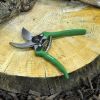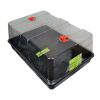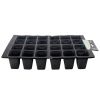How to Propagate your Plant Cuttings (Hardwood)
Propagating hardwood trees & shrubs is a great way to increase your stock of plants without spending any money. Making hardwood cuttings is an easy process however you will need to nurse your plants for the first 12 months until they have established a sufficient root system.
What you will need to propagate hardwood cuttings
- A good, clean and sharp secateurs is essential for making neat cuts
- 9cm plant pots or single cell trays
- General potting compost
- Sharp sand or perlite for your potting mix
- Plant labels
- A mister
- Clear plastic bags or cling film
- Rooting powder
- And ideally a cold frame
When is the best time to make hardwood cuttings?
- During the dormant season
- This runs from late October through to late February
- Avoid taking cuttings in frosty weather
How to make the cutting
- First choose healthy stems for your cuttings. You want wooded stems that aren't more than two years old
- These younger wooded stems are more active in growing & will develop new roots quicker than older wood
- The stems should be 10cm in length, straight & about the thickness of a pencil
Preparing the cutting
- Next, prepare the cutting by removing the ‘apical’ or terminal bud, this is the bud at the tip of the stem
- Next you will remove 2/3 of all leaves, starting from the bottom of the stem, up
- Removing most of the leaves helps to conserve the cutting’s limited water supply, whilst leaving the remaining leaves allows the cutting to continue making food
- Next, make a final cut at the rooting end of the cutting. When doing this you must first find an existing bud or node, make a slanted cut through the stem, keeping the bud or node on the cutting (this is where the new roots will develop from). When making the cut, be sure to that it is neat and clean, making sure not to crush or damage the stem
- All this should be done promptly. To avoid letting your cuttings dry out keep them out of the sun until they are potted up
Potting up
Pots, trays or containers should always be prepared before making your cuttings; this is to prevent cuttings from drying out. We recommend using cell trays or propagator trays for smaller cuttings such as lavender and 3 inch plastic pots for larger cuttings such as Hydrangea.
How to prepare the potting mixture
- 1 part peat-free potting compost
- 1 part perlite or sharp sand
- 15gm superphosphate for every 5 litres of potting mixture
- Mix all well
Superphosphate is a straight fertiliser that promotes root development and growth. Place soil into trays or pots, lightly compress and soak with water. Using a pencil or dibber, make a hole in the centre of each pot, into which the cutting will be placed.
To encourage root establishment we recommend that you use rooting powder. To do so, dip the base (1 inch) of each cutting into water and then dip it into the rooting powder (rooting powder is a natural plant hormone that promotes root growth). Shake off the excess powder and place the cutting into the hole made in the compost. Firm in the compost around the cutting making sure that the cutting is secure and won’t move easily.
After care
- This is the vital part! The key to cuttings is to keep them moist at all times, without encouraging fungal growth
- Place plants in a cold frame or greenhouse
- Use a garden tray & capillary matting underneath to provide even water distribution
- Hard wood cuttings need to be over wintered, so you will need to choose a cool place that is free of frost
- If the cuttings are exposed to the winter freeze, they will die
- You can mulch the surface of the pots or trays with perlite to help retain moisture in the cutting’s compost while reducing the impact of the cold weather
- After 12 months the cuttings should have developed sufficient roots and can be potted on into larger pots
What plants are suited to hardwood cuttings
Most hardwood plants, including shrubs, roses, and trees
- Cornus
- Rose
- Buddleia
- Weigela
- Cotoneaster
- Gooseberry
- Fig
- Raspberry
- Blackberry








